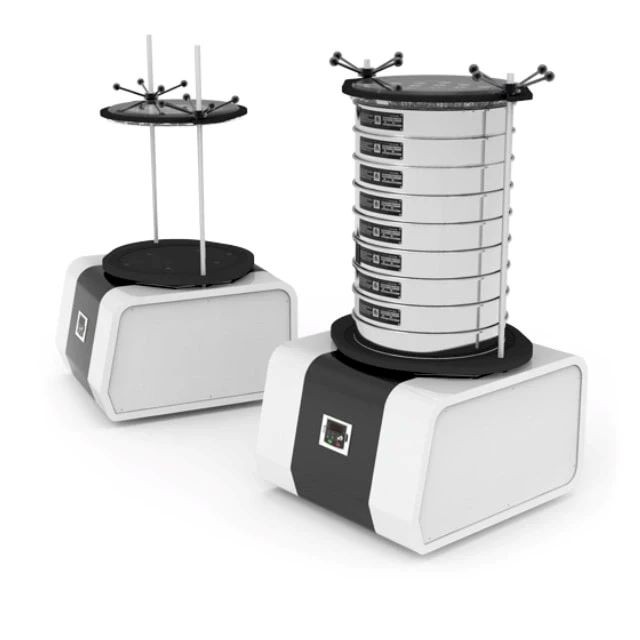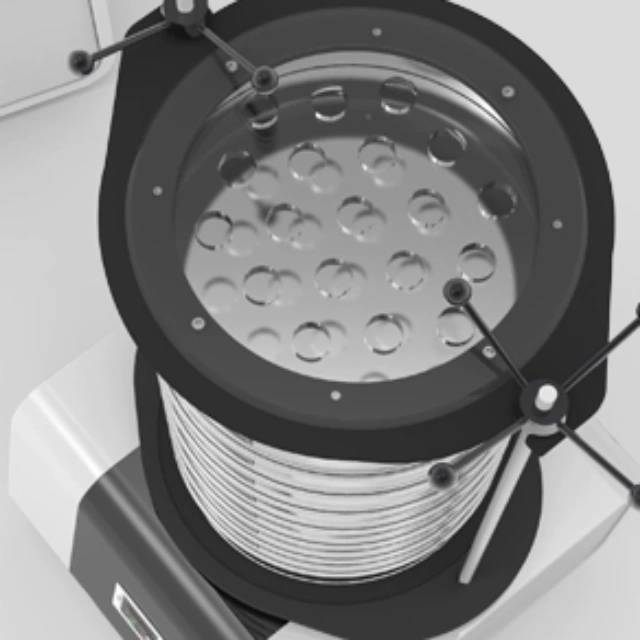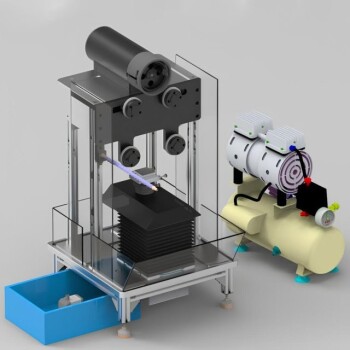
Sieving Machine
Laboratory Test Sieves and Vibratory Sieve Shaker Machine
Item Number : KT-V400
Price varies based on specs and customizations
- Maximum load
- 25 kg
- Maximum number of stages
- 9 / 13 kg
- Maximum sieve tower mass
- 56 kg
- Amplitude
- 0.8-4 mm
- Vibration frequency
- 3000 times/min
- Screening particle size range
- 75 um-125 mm
Shipping:
Contact us to get shipping details Enjoy On-time Dispatch Guarantee.
Why Choose Us
Easy ordering process, quality products, and dedicated support for your business success.
Introduction
Processing principle: high-frequency three-dimensional parabolic motion
Application samples: Powder | granular | small block | loose | suspended solids, etc.
Processing type: Particle size determination, separation, classification
Main functions: Frequency conversion digital control | timing | vibration frequency adjustment | continuous screening | intermittent screening

Applications
The Vibration Sieve, including both three-dimensional vibrating screeners and rotary vibrating sieves, is a versatile tool in various industries for material analysis and processing. These devices are particularly effective in particle size analysis, morphology analysis, and distribution analysis, ensuring high precision and efficiency in material screening.
- Particle Size Analysis: Used in laboratories to determine the size distribution of granular materials, ensuring that products meet specific size requirements.
- Pharmaceuticals: Essential for maintaining the consistency and quality of pharmaceutical products by ensuring uniform particle sizes.
- Food Industry: Helps in the grading and separation of food ingredients, enhancing the quality and consistency of food products.
- Chemical Industry: Used for the classification and purification of chemical substances, ensuring the purity and effectiveness of chemicals.
- Metal Powder Processing: Ideal for the screening of metal powders used in various manufacturing processes, including 3D printing.
- Water Treatment: Effective in the filtration and separation processes in water treatment facilities, ensuring the quality of treated water.
- Agriculture: Used for grading seeds and grains, contributing to better crop management and yield.
- Ceramics: Helps in the preparation of ceramic materials by ensuring the correct particle size distribution.
- Rubber and Plastic Industries: Used for the grading and quality control of raw materials, ensuring the consistency of final products.
- New Materials Research: Essential in the development and testing of new materials, ensuring they meet specific particle size and distribution requirements.
Features
The three-dimensional vibrating screener, also known as a sieve shaker, is a versatile and efficient laboratory instrument designed for screening and separating granular materials. This device utilizes high-frequency, small-amplitude vibrations to enhance the screening process, making it both energy-efficient and highly productive. Here are the key features and benefits that make this equipment a valuable asset in various laboratory settings:
- Wide Screening Range: Capable of handling a variety of materials including powders, granules, and even mucus, ensuring versatility in application.
- High Efficiency and Continuous Operation: Designed to operate continuously for 24 hours, maximizing productivity and meeting high-volume processing needs.
- Non-Clogging Mesh with Advanced Cleaning Systems**: Equipped with a bouncing ball and ultrasonic cleaning systems, preventing mesh clogging and ensuring smooth, uninterrupted screening operations.
- Durable and Easy-to-Change Screens: Features a unique grid design that extends the life of the screen and allows for quick, hassle-free screen replacements in just 3-5 minutes.
- Customizable Layers: Offers the flexibility to choose the number of screen layers, up to five, to accommodate different material processing requirements.
- Precise and Repeatable Results: Utilizes a 3-D throwing motion and precise mesh to deliver fast, consistent results, ideal for both wet and dry fine sieving.
- Stainless Steel Construction: Built with SUS304 stainless steel, ensuring durability and resistance to corrosion, making it suitable for various laboratory environments.
These features not only enhance the functionality of the vibrating sieve but also significantly improve the efficiency and effectiveness of particle size analysis, morphology analysis, and distribution analysis in laboratory settings.
Advantage
The three-dimensional vibrating screener, also known as a sieve shaker, offers numerous advantages in laboratory settings, particularly in particle size analysis, particle morphology analysis, and particle distribution analysis. Here are the key benefits of using a vibration sieve:
- Energy Efficiency: The high-frequency, small-amplitude vibration mode employed by these machines is highly energy-efficient, reducing operational costs while maintaining high screening efficiency.
- Enhanced Screening Efficiency: The vibration force allows for quick separation of granular materials, significantly improving the processing capacity and overall efficiency of the sieving process.
- Improved Accuracy and Repeatability: Unlike manual agitation, which can be inconsistent due to human factors, a sieve shaker provides precise and repeatable results, ensuring that each test is conducted under the same conditions.
- Programmable Features: Many models come equipped with programmable timers and adjustable vibration speeds, allowing for customized sieving processes tailored to specific testing requirements.
- Multilevel Testing: These machines can handle multiple sieves at once, enabling simultaneous testing of different particle sizes, which is more efficient than testing one sieve at a time.
- Durability and Material Quality: Constructed with materials like SUS304 stainless steel, these machines are robust and resistant to corrosion, ensuring long-term reliability and minimal maintenance.
- Versatility: Suitable for both wet and dry fine sieving, the vibration sieve is versatile and can be used in various applications, including civil engineering and material science.
- 3-D Throwing Motion: The unique three-dimensional throwing motion ensures that all particles are effectively agitated and screened, leading to faster and more reliable results.
These advantages make the vibration sieve an indispensable tool in modern laboratories, providing efficient, accurate, and reliable screening of granular materials.
Technical specifications

| Maximum load | 25 kg |
| Maximum number of stages | 9/13kg |
| Maximum sieve tower mass | 56 kg |
| Amplitude | 0.8-4 mm |
| Vibration frequency | 3000 times/min |
| Screening particle size range | 75 um-125 mm |
| The largest available screen diameter | 400mm |
| Maximum sieve tower height | 960mm |
| Additional function | Comfortable visual screen press plate |
| Screening method | Dry |
| Electrical description | 100-120V/200-240V AC, 50-60Hz, 1500W |
| Power port | National standard / European standard / American standard / British standard, etc. |
| Net weight | 98 kg |
| Dimensions (width, thickness and height) | 600*660*1260mm |
| Protection level | IP65 |
| Standard | CE/ISO9001 |
Warnings
Operator safety is the top important issue! Please operate the equipment with cautions. Working with inflammable& explosive or toxic gases is very dangerous, operators must take all necessary precautions before starting the equipment. Working with positive pressure inside the reactors or chambers is dangerous, operator must fellow the safety procedures strictly. Extra caution must also be taken when operating with air-reactive materials, especially under vacuum. A leak can draw air into the apparatus and cause a violent reaction to occur.
Designed for You
KinTek provide deep custom made service and equipment to worldwide customers, our specialized teamwork and rich experienced engineers are capable to undertake the custom tailoring hardware and software equipment requirements, and help our customer to build up the exclusive and personalized equipment and solution!
Would you please drop your ideas to us, our engineers are ready for you now!
FAQ
What Are The Main Applications Of Laboratory Sieve Shakers?
What Is A Test Sieve?
What Are The Key Features Of Laboratory Sieve Shakers?
What Are The Main Applications Of Test Sieves?
How Does A Laboratory Sieve Shaker Work?
How Does A Test Sieve Work?
What Are The Advantages Of Using A Laboratory Sieve Shaker?
What Are The Different Types Of Test Sieves?
What Types Of Laboratory Sieve Shakers Are Available?
What Are The Advantages Of Using A Test Sieve?
Can Test Sieves Be Used For Both Dry And Wet Samples?
What Is A PTFE Mesh Sieve, And Where Is It Used?
4.8 / 5
I was apprehensive at first, but the KINTEK Vibration Sieve has exceeded my expectations. It's a game-changer for our laboratory, delivering precise and consistent results.
4.9 / 5
The KINTEK Vibration Sieve is a testament to engineering excellence. Its user-friendly design and advanced features make it an indispensable tool in our lab.
4.7 / 5
The KINTEK Vibration Sieve has revolutionized our material testing process. It's incredibly efficient, delivering accurate results in a fraction of the time.
5.0 / 5
The KINTEK Vibration Sieve is an absolute gem. Its durability and reliability are unmatched, making it a worthy investment for any laboratory.
4.6 / 5
The KINTEK Vibration Sieve has brought new life to our laboratory. Its innovative design and exceptional performance make it a must-have for any professional.
4.8 / 5
The KINTEK Vibration Sieve is a testament to quality craftsmanship. It's incredibly well-built, ensuring years of reliable service.
4.9 / 5
The KINTEK Vibration Sieve is a game-changer for our laboratory. Its advanced features and intuitive interface make it a pleasure to use.
5.0 / 5
The KINTEK Vibration Sieve is worth every penny. It has significantly improved our efficiency and accuracy, making it an indispensable tool in our lab.
REQUEST A QUOTE
Our professional team will reply to you within one business day. Please feel free to contact us!
Related Products

Three-dimensional electromagnetic sieving instrument
KT-VT150 is a desktop sample processing instrument for both sieving and grinding. Grinding and sieving can be used both dry and wet. The vibration amplitude is 5mm and the vibration frequency is 3000-3600 times/min.

Laboratory Vibratory Sieve Shaker Machine for Dry and Wet Three-Dimensional Sieving
KT-VD200 can be used for sieving tasks of dry and wet samples in the laboratory. The screening quality is 20g-3kg. The product is designed with a unique mechanical structure and an electromagnetic vibrating body with a vibration frequency of 3000 times per minute.

Laboratory Wet Three-Dimensional Vibratory Sieve Shaker Machine
The wet three-dimensional vibrating sieving instrument focuses on solving the sieving tasks of dry and wet samples in the laboratory. It is suitable for sieving 20g - 3kg dry, wet or liquid samples.

Vibratory Sieve Shaker Machine Dry Three-Dimensional Vibrating Sieve
The KT-V200 product focuses on solving common sieving tasks in the laboratory. It is suitable for sieving 20g-3kg dry samples.

Laboratory Vibratory Sieve Shaker Machine Slap Vibrating Sieve
KT-T200TAP is a slapping and oscillating sieving instrument for laboratory desktop use, with 300 rpm horizontal circular motion and 300 vertical slapping motions to simulate manual sieving to help sample particles pass through better.

High Precision Diamond Wire Cutting Machine Laboratory Saw Precision Wire EDM Cutting Machine
The high precision diamond wire cutting machine is a versatile and precise cutting tool designed specifically for material researchers. It utilizes a continuous diamond wire cutting mechanism, enabling precise cutting of brittle materials such as ceramics, crystals, glass, metals, rocks, and various other materials.

Laboratory Manual Hydraulic Pellet Press for Lab Use
Efficient sample preparation with small footprint Manual Lab Hydraulic Press. Ideal for material researching labs, pharmacy, catalytic reaction, and ceramics.

Laboratory Hydraulic Press Lab Pellet Press Machine for Glove Box
Controlled environment lab press machine for glove box. Specialized equipment for material pressing and shaping with high precision digital pressure gauge.

Laboratory Planetary Ball Mill Cabinet Planetary Ball Milling Machine
The vertical cabinet structure combined with ergonomic design enables users to obtain the best comfortable experience in standing operation. The maximum processing capacity is 2000ml, and the speed is 1200 revolutions per minute.
Related Articles

Innovative screening technology: Laboratory three-dimensional vibrating screen leads the new industry standard
Learn about the working principle of the dry three-dimensional vibrating screener and its applications. Understand the vibration force generation and three-dimensional throwing motion. Discover the adjustment function and intelligent control of the screener. Explore the features and benefits of using the dry three-dimensional vibrating screener in laboratory and industrial settings.

The Scientific Principle of Sieving: Understanding Particle Size Distribution and Laboratory Test Sieves
Learn about the scientific principle of sieving, including the process of separating particles based on size, types of laboratory test sieves. Discover how sieving impacts various industries and the accuracy of particle sizing measurements.

The Ultimate Guide to the Application and Benefits of Vibratory Sieve Shaker in Laboratory Testing
Discover the extensive application of vibratory sieve shaker in laboratory testing for industries such as food, medicine, chemical, and more. Learn about the benefits of using a sieve shaker.

Revolutionizing Lab Efficiency: The Ultimate Guide to Laboratory Sieving Machines
Discover the common sieving methods used in laboratory analysis. Learn about single sieve and sieve set sieving, dry and wet sieving, and other techniques for effective particle separation. Find out how sieving has evolved over time and its importance in quality assurance.

Unlocking the Power of Sieving Machines: Functions, Applications and Maintenance
Discover the significance of sieving machines in various industries and the essential functions they serve. Learn about the the maintenance requirements for optimal performance. Explore the benefits of using sieve shakers for automating the particle separation process.

Sieving technology for particle size analysis and its applications
Introducing screening technology, explaining the working principle of vibrating screens and the advantages of using them for particle size analysis in screening technology. Learn about the types of vibrating screens and how to choose one.

Three-Dimensional Vibrating Sieve: Working Principle and Application Fields
Discover the working principle and application fields of the three-dimensional vibrating screener. Learn how this laboratory equipment uses vibration force to efficiently separate and analyze granular materials. Explore its uses in the pharmaceutical, chemical, and various other industries.

The Three Stages of Lab Crushing: A Comprehensive Guide
Learn about the three stages of crushing: primary, secondary, and tertiary, and how they are used in sample preparation for scientific analysis. Discover the different types of crushers and their applications in reducing bulky materials into smaller particles.

FTIR Pellet Press The Game-Changer in Spectroscopy Analysis
Fourier Transform Infrared Spectroscopy (FTIR) is a widely used analytical technique in the field of chemistry and materials science. It is a non-destructive method that allows the identification and quantification of chemical compounds in a sample.

The Role of Powder Characteristics in Cold Isostatic Pressing
Cold Isostatic Pressing (CIP) is a powder compaction technique that involves applying uniform pressure to a powder-filled container from all directions.

Rotary Furnaces: A Comprehensive Guide to Advanced Materials Processing
Rotary furnaces are widely used for advanced materials processing due to their versatility, temperature uniformity, and energy efficiency. This guide provides an overview of rotary furnace technology, including its working principle, applications, design improvements, and control systems.

How To Turn XRF analysis sample preparation Into Success
In X-ray fluorescence (XRF) analysis, sample preparation is an important step because it can significantly impact both the quality and the efficiency of the analysis.